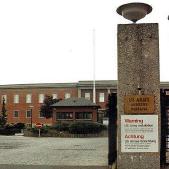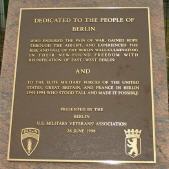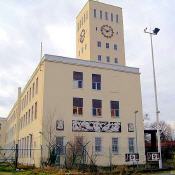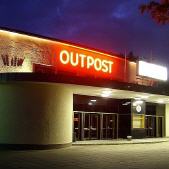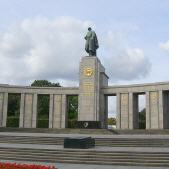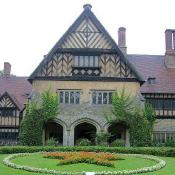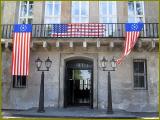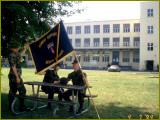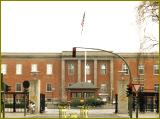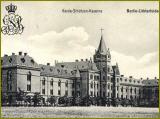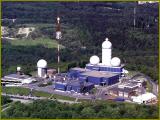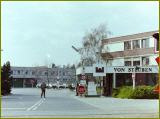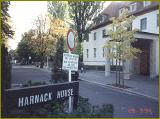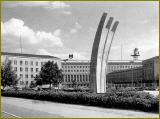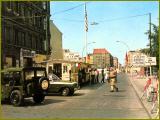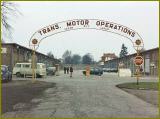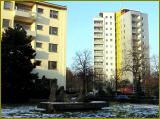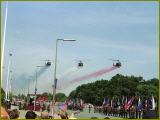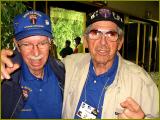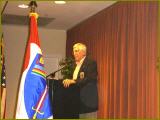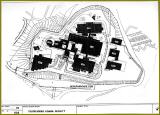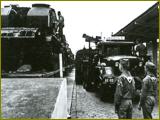YOU ARE HERE:
HOME
BERLIN BRIGADE
U.S. Army Berlin (USAB) was a command of the United States Army created in December 1961 at the height of the Berlin Wall Crisis. It was created as a separate command from the U.S. Army Europe (USAREUR) which had previously been in command of American troops in Berlin. The shoulder sleeve insignia adopted by USAB was the same as the patch used by the Berlin Brigade - the USAREUR patch with a Berlin tab. Its headquarters was located at the Clay Headquarters Compound on Clayallee.
Units under the command of USAB included the Berlin-Brigade, the Medical and Dental Activities, Tempelhof Central Airport (United States Air Force base), Armed Forces Network (radio and television), the Military Liaison Mission, and United States Army Field Station Berlin.
|
Troops of USAB were housed at several kasernes around the city, including Andrews Barracks, McNair Barracks, and Turner Barracks. Families lived in the housing areas near the Clay Compound, and in the Dueppel and Dahlem neighborhoods of Berlin. Truman Plaza, located across Clayallee from the Clay Compound, held the post exchange, commissary, Army post office (APO), American Express bank, Stars & Stripes book store, barber, florist, Deutsche Post, and the Major Arthur D. Nicholson Memorial Library. Schools for the children of service members were located close to Truman Plaza.
After the reunification of Germany, U.S. Army Berlin was deactivated in 1994.
|
|
ANDREWS BARRACKS |
BERLIN U.S. MILITARY VETERANS ASSOCIATION (BUSMVA) |
MCNAIR BARRACKS |
|
OUTPOST THEATER |
SOVIET MEMORIAL |
SCHLOSS CECILIENHOF |
LINKS
________________________________________________________________________________________
Clay Headquarters
The headquarter complex for the United States Army, Berlin, was located at the corner of Clayallee and Saargemuender Strasse in Dahlem, Zehlendorf. This district, built up mainly between the turn of the century and the late 1930´s, was the location of many villas built by wealthy industrialists and financiers.
McNair Barracks
McNair Barracks occupies the site of the former AEG Telefunken electronics factory, a Nazi-era complex. During the war, research took place on some of the "miracle" weapons that Hitler hoped would turn the tide of the war. One of the most important products to be developed and produced in the factory was a radar-guided flak control system which could ascertain range and select individual targets.
Andrews Barracks
Andrews Barracks was originally constructed in 1873-74 as the Imperial "Hauptkadettenanstalt" - the main military academy of the German Empire. The decision to build this academy followed the creation of a German state in 1871. In the aftermath of German unification, the Kaiser wanted to centralize military instruction, previously conducted at three academies, into one institute. The first class of the academy graduated in 1878. During World War I, nearly 3,000 graduates of the "Hauptkadettenanstalt" died.
Roosevelt Barracks
The complex now known as Roosevelt Barracks was built in 1884 to house a Royal Prussian Guards Regiment. It was used for this purpose until the end of World War I, when it was occupied by Berlin Police units. It later became site of the German Army Ordonance School, a function it served through World War II.
Teufelsberg Radar Station
On the hill "Teufelsberg", in the british sector, the US National Security Agency (NSA) built one of its largest listening stations. Some people think, it was part of the global "ECHOLON" intelligence gathering network.
Directorate of Engineering & Housing
Units of DEH: Work Order Office, Costumer Service, Housing Division, Dahlem Guest House, Engineer Resource Management Division, Engineering Plans & Services Division, Supply Support Division, Buildings & Grounds Division, Utilities Division, Fire Protection Division
Harnack House
The Harnack House was opened in 1929 as a centre for German scientific and intellectual life. The House was not significantly damaged at the end of the war, and after a short period in Soviet hands it became an officers' mess for the occupying U.S. Army, though because of its historical prestige it was also used for cultural and diplomatic events.
Tempelhof Central Airport
The 852nd Engineer Aviation Battalion arrived at Tempelhof on 10 July 1945. United States Army Air Force units also took over the airfield, and the 862nd Engineer Aviation Battalion built a concrete runway. With the formation of the United States Air Force in 1947, Tempelhof became a USAF base. The United States Air Forces in Europe (USAFE) renamed the facility to Tempelhof Air Base ...
Checkpoint Charlie
Here you will see photos of Checkpoint Charlie. There are photos about the Berlin Wall Crisis in 1961, during the Cold War, and after the german reunion.
Transportation Motor Pool
Transportation Motor Pool was located at Andrews-Barracks. You will see photos of coworkers, repair shops and vehicles.
Housing Areas
Photos of the former Housing Areas: BB-Area, Dreipfuhl Area, Pueckler Area, Dueppel Area, Sundgauer Area and Baseler Strasse.
4th of July celebrations
Here you will see photos and videos of the 4th of July celebrations after 1994 held on McNair-Barracks compound at the McNair-Museum.
BUSMVA Reunion 2006
Photos of the 2006 reunion in Berlin
BUSMVA Reunion 2010
Photos of the 2010 reunion in Berlin
Maps
Maps of all U.S. installations of the Berlin-Brigade, inclusive T-Berg, Document Center, TCA, Checkpoints: Alpha Bravo and Charlie, Helmstedt properties ...
RTO
Photoalbum about the UNITED STATES ARMY TRANSPORTATION CORPS DUTY TRAIN stations (RTO) in Berlin.
today: 24 - total: 3465.
This web site was implemented on July 29, 2007
